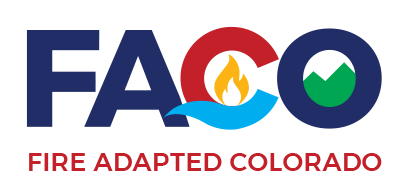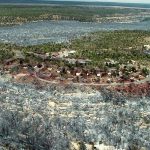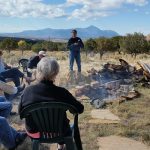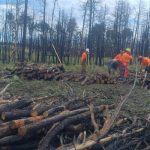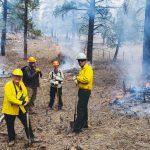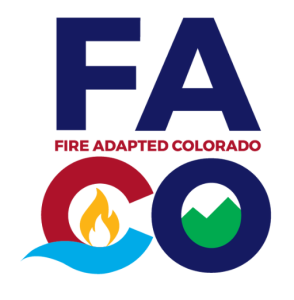Full Circle: From Nine Year Old Tree Hugger to Creating Opportunities to Coexist with Wildfires
by Rebecca Samulski, Executive Director of Fire Adapted Colorado – DONATE TO FACO’s OPPORTUNITY FUND FOR GIVING TUESDAY
As a young girl, I grew up in a historic duplex with a shake shingle roof on a canyon rim in Mesa Verde National Park, surrounded by ancient piñon pine and juniper trees. At the time, Tim Oliverius, a savvy fire management officer recognized the need to protect the park employees, visitors, and historic structures and was successful in getting most of the roofs replaced with fire rated asphalt shingles. He also launched an extensive thinning project around the homes and other historic park buildings like the rec hall and museum. I remember attending the neighborhood meeting for park residents to discuss the tree cutting project as a tree hugging nine-year old. With my hands on my little hips, I asked Tim why he wanted to cut down 400 year old juniper trees in my front yard.
Five years later, after the trees were gone and I’d moved outside of the national park, that home was one of only a couple that burned down from embers intruding through un-screened attic vents during the Long Mesa Fire, leaving my long-time neighbor homeless along with the park family who moved in after us with a young son.
Fast-forward Seventeen Years: Ridge Subdivision Fire
Last weekend, I left my home to take my two sons to go see a play. This is the home I’ve inherited that I built with my parents after we moved out of the park. Pulling out of the driveway, I could see dark smoke billowing across the canyon during the driest fall in southwest Colorado on record. I checked my phone for the Active 911 alert I was sure to get from the Volunteer Fire District, which promptly came up with the page for us to respond for the fire. This fire was obviously between me and my in-laws’ home, where Granny was going to join us on the way to the play. As we drove closer to the fire, we discovered it was spreading in the grass in a neighboring subdivision, and only a resident visible walking with a garden hose toward a house indicated any response to the flames that were quickly approaching on the other side. This is the neighborhood that the retired Fire Management Officer lives in now!
I had to keep going to let Granny take my boys to the high school play without me. I called dispatch to request mutual aid and give a better fire location and size-up of the growing fire and changed into my wildland fire PPE. I also alerted my husband to pack the truck and called a neighbor to activate our community phone tree list with a heads-up, a preparedness action I expected to move much quicker than the county’s emergency alerts. I was back on-scene spraying water and digging line within 15 minutes. Fortunately some prior preparedness work by homeowners made a big difference and evacuations did not become necessary.
Neighbors had already been talking about wildfire together and with their fire department at the invitation of the retired fire manager this year. They were planning and preparing for fire with the information and tools that had been shared with them.
The homes and outbuildings that were threatened had defensible space, including non-combustible perimeters.
The grass had been mowed. Other dried grasses are waist high this fall, but this fire was less intense because it ran into grass mowed to less than six inches.
Neighbors had a key and knew how to turn on the outdoor water for the most directly threatened home which had been winterized by the homeowners who’d gone south for the winter.
They had learned what they could do and taken actions to become more resilient when a fire started.
The Value of the Fire Adapted Colorado Network
The resources, connections, and ideas that I have gleaned from professionals working in other places around the state and country have been invaluable toward reducing wildfire impacts in my landscape. This is why I am grateful for the opportunity to coordinate Fire Adapted Colorado (FACO), a statewide non-profit network accelerating wildfire risk reduction among local wildfire preparedness leaders since 2015.
I have had the privilege of working with many motivated residents who have developed a new understanding and way of living with wildfire in my community. From helping a group of residents take on a community slash chipping project with support of the chipper rebate program, to helping catalyze a broad group of community leaders across two counties to launch a 600,000+ acre forest and community resilience initiative, I understand first-hand the needs and opportunities to help Coloradans coexist with wildland fire.
Fire Adapted Colorado fosters connections between place-based professionals and state and national organizations and agencies, science and land-use planning researchers, and business, industry, and utility partners that support and influence their work. Since I was hired as the part-time Director for FACO in October 2018, we have expanded from supporting 30 individual members to supporting 52 individuals representing 39 organizations. Through our connections, collective voice, and statewide Colorado Wildland Fire Conference, we improve the ability for FACO members and our partners to accomplish more effective and efficient local fire resilience work. This includes the reduction of wildfire risk, expansion of quality prescribed fire use, increased community preparedness, and improved and appropriate wildfire response.
Opportunity Fund to Propel Local Efforts Forward
The local wildfire preparedness leaders who volunteer on our board are seeking to raise at least $10,000 to offer an Opportunity Fund to our members again in 2020. Our Opportunity Fund is a mini-grant program that fosters local solutions that are difficult to fund through traditional funding sources. It has been amazing to witness what local groups have achieved in 2018 and 2019 with less than $2,500 and less than six months to move wildfire risk reduction forward. The fund has fulfilled needs for eleven separate projects including outreach and educational materials, field equipment, support for cooperative burning, and initiation of vegetation thinning projects.
FACO members have even accomplished projects with benefits far beyond their local community, such as a photo library of common home retrofits and construction and landscaping techniques that reduce home ignitions by the Boulder Wildfire Partners program that they have made available for anyone to use.
Opportunity Fund award recipients have included clockwise from top left: the Dolores Watershed Resilient Forest Collaborative for cooperative pile burning; Wildfire Adapted Partnership outreach materials for name change; New field vests and equipment for West Region Wildfire Council to conduct site visits and mark trees for removal; Greater Eagle Fire Protection District for first masticated fuel breaks of their Fire Adapted Eagle project.
Each year the Opportunity fund has received more demand than we have been able to meet. Several members have expressed interest in a more flexible funding source for inspired, well-calculated projects that were beyond the scope of what was possible with the original Opportunity Fund. Please DONATE THIS GIVING TUESDAY to help us offer the best Opportunity Fund yet to our growing membership.
Your support helps dozens of local wildfire preparedness leaders like me to more effectively engage a growing share of our community members in doing all they can to coexist with wildland fire. If you would like to connect with local resources to find out how you can help, visit our website and contact me. If you are a local wildfire preparedness professional and aren’t already a member, you can learn more about becoming a member on the FACO website.
(Initial support for FACO’s Opportunity Fund was provided by the United States Forest Service and The Nature Conservancy through a cooperative agreement with the Watershed Research and Training Center supporting the Fire Adapted Communities Learning Network. This funding has been amazing for jump-starting the Opportunity Fund and showing very tangible outcomes of Fire Adapted Colorado. It also created a time-limit shorter than a field season and was somewhat restrictive on how funds could be spent and how they needed to be matched by the recipients.)
